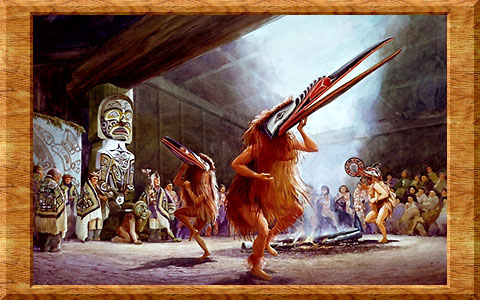
KWAKIUTL CEREMONIAL DANCE MASK

Winter Dance, by Gordon Miller
This
particular Kwakiutl dance mask, was used in winter
ceremonies. It represents Hokhokw, a man-eating bird.
There is a hinge on the long beak. Ceremonial dancers would
leap up and snap the beak closed with a loud clap. This
particular mask was made in the late 19th century. Today,
carvers create modern versions that are used in performances of
the traditional dance.
GWAKWIWE
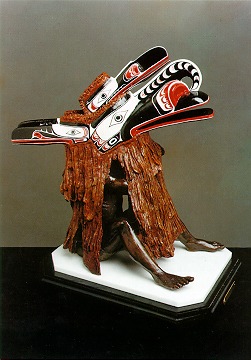
Kwagiulth Dancer
This is an intricate bronze
sculpture that depicts a Kwagiulth dancer. The dancer is
wearing a three way Raven transformation mask. This is one
of many traditional masks that was created by the southern
Kwakiutl. The dancer hidden in the hug cedar mask, becomes Gwaxwiwe'
or Raven transforming. The
face is hinged and by opening it up this face changes from Raven
to Killer Whale, and finally into the Human Spirit. In
Kwakiutl tradition, respected families gained ownership of
particular dances telling stories and legends. For many
generations, dancers have taken great pride in dazzling Potlatch
guests with dramatic movements and stunning masks.
MUGAMT

Mugamt by Jack Gibson
This figure represents a Kwagiulth Mugamt dancer and was sculpted by Jack Gibson after personally observing a traditional Potlatch -- a very rare experience -- and studying the form of the dancer and his remarkable bird mask. These dramatic masks demonstrate a most unique and imaginative example of art produced by the Kwagiulth. This particular mask depicts the traditional Kwagiulth multiple bird mask which was worn by high-ranking dancers, and represented the bird monster spirits in rare traditional dances performed in the dramatic fireside ceremonies of the southern Kwakiutl.
This again
was a huge hand carved mask with a hinged beak and took great
strength, skill and co-ordination by the dancer to operate the
concealed strings in order that the loud cracking noise could be
made as he leapt into the air in a spirit induced frenzy, swaying
to the sounds of rattles and drums.
POTLATCH
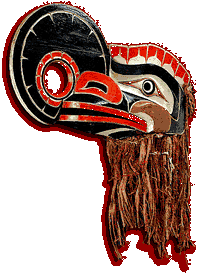
Galukw'ami
Mask of the Crooked Beak
'Nakwaxda'xw band, Willie
Seaweed, ca. 1940
Red cedar, red cedar bark,
mahogany plywood, leather, cord
Potlatch traditions continue
today, just as they have done for hundreds of years. Some
of the details have changed over time, however. With the
arrival of Europeans to the Americas, Pacific Northwest
cultures were greatly affected by outside influences. There
was a time when the Canadian government and Canadian religious
leaders wanted the First Peoples to give up their traditional
ways and become more like other Canadians. There was a time
starting in 1885, when Potlatches and their related activities
were prohibited by Canadian law.
The prohibition was finally lifted in 1951, but prior to that time, there were still Potlatches that were held in secret in many places. The sad part of the prohibition was that many of the old ways and the knowledge of tradition were lost during that time. The people say of this period, "Luhlpadax'idan's 'nalax" (When our world became dark).
The Kwakwaka'wakw fought very hard, both during the time of the prohibition of the potlatch and since then, to preserve their ceremonial traditions and the potlatch. And why do you think it was important for the Kwakwaka'wakw to keep their ceremonial traditions?
Look very
carefully at the art objects and you will see they tell of the
drama and impact of potlatching traditions.
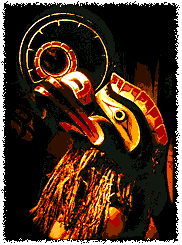
Kwakwaka'wakw
dancer Kevin Cranmer wears Mask of the Crooked Beak
BUKWAS
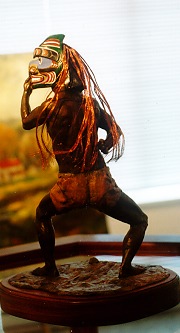
Bukwas
Bukwas, or
wild man of the woods, is a significant supernatural spirit being
of the Kwakwaka'wakw Nation and casts a
haunting figure in their great annual winter dance. Bukwas
is linked with the underworld of the dead and with ghosts --
especially the spirits of the drowned who hover near him.
This mysterious and illusive wild man lurks near the edge of the
dark forest where he lives, offering food to lost humans, luring
them to become spirits in his shadowy underworld. This
figure represents a Kwakwaka'wakw dancer
wearing a carefully carved cedar mask, portraying Bukwas creeping
to a sand bank on a sunny morning to dig for cockles, which is
his favourite food. He is very shy and looks about to see
if he is being watched, shading his face from the sun with his
hands. Suddenly he leaps forward, settles on one knee
searching for cockles, and devours them quickly, occasionally
uttering a high pitched whoop or shriek from a concealed whistle.
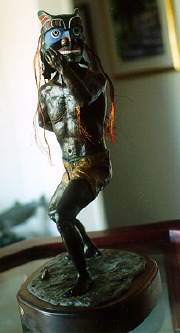
Bukwas